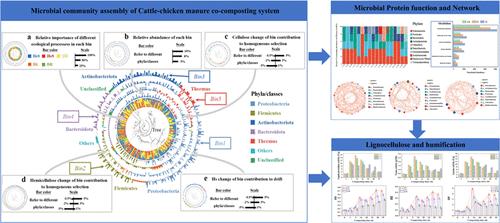Enhanced Humification Efficiency and Lignocellulose Degradation by Cattle-Chicken Manure Co-Composting System: Microbiome In-Depth Analysis
IF 7.3
1区 化学
Q1 CHEMISTRY, MULTIDISCIPLINARY
引用次数: 0
Abstract
Traditional composting faces issues such as slow degradation of lignocellulose and poor humification, which are closely related to the microorganisms in the compost. However, the microbial succession and mechanisms involved are still not well understood. This study established a cattle-chicken manure co-composting system and investigated the microbial community succession process in this system through microbial community diversity analysis. The microbial community prediction model, based on phylogenetic bin analysis, network modeling, and protein function prediction, is used to infer the mechanisms of microbial community assembly in the system. This helps explain how the system accelerates the degradation and conversion of lignocellulose and the formation of humic acids. The results indicate that during community succession, the system enhanced microbial protein functions, strengthened cooperation among microbial communities, and increased the stability of community assembly. This ultimately led to an increase in the cellulose degradation rate by 12.54%, hemicellulose degradation rate by 21.12%, lignin degradation rate by 9.97%, and humic acid content by 36.82%. This study demonstrates the value of the system and provides new insights into the mixed treatment of solid organic waste in the future.

牛鸡粪协同堆肥系统提高了湿化效率和木质纤维素降解:微生物组深入分析
传统堆肥面临着木质纤维素降解慢、腐殖化差等问题,这与堆肥中的微生物密切相关。然而,人们对其中的微生物演替和机制仍不甚了解。本研究建立了牛鸡粪共堆肥系统,并通过微生物群落多样性分析研究了该系统中的微生物群落演替过程。基于系统发育宾分析、网络建模和蛋白质功能预测的微生物群落预测模型,用于推断该系统中微生物群落的组装机制。这有助于解释该系统如何加速木质纤维素的降解和转化以及腐殖酸的形成。结果表明,在群落演替过程中,该系统增强了微生物蛋白质功能,加强了微生物群落间的合作,提高了群落组装的稳定性。最终,纤维素降解率提高了 12.54%,半纤维素降解率提高了 21.12%,木质素降解率提高了 9.97%,腐殖酸含量提高了 36.82%。这项研究证明了该系统的价值,并为今后混合处理固体有机废物提供了新的思路。
本文章由计算机程序翻译,如有差异,请以英文原文为准。
求助全文
约1分钟内获得全文
求助全文
来源期刊

ACS Sustainable Chemistry & Engineering
CHEMISTRY, MULTIDISCIPLINARY-ENGINEERING, CHEMICAL
CiteScore
13.80
自引率
4.80%
发文量
1470
审稿时长
1.7 months
期刊介绍:
ACS Sustainable Chemistry & Engineering is a prestigious weekly peer-reviewed scientific journal published by the American Chemical Society. Dedicated to advancing the principles of green chemistry and green engineering, it covers a wide array of research topics including green chemistry, green engineering, biomass, alternative energy, and life cycle assessment.
The journal welcomes submissions in various formats, including Letters, Articles, Features, and Perspectives (Reviews), that address the challenges of sustainability in the chemical enterprise and contribute to the advancement of sustainable practices. Join us in shaping the future of sustainable chemistry and engineering.
 求助内容:
求助内容: 应助结果提醒方式:
应助结果提醒方式:


